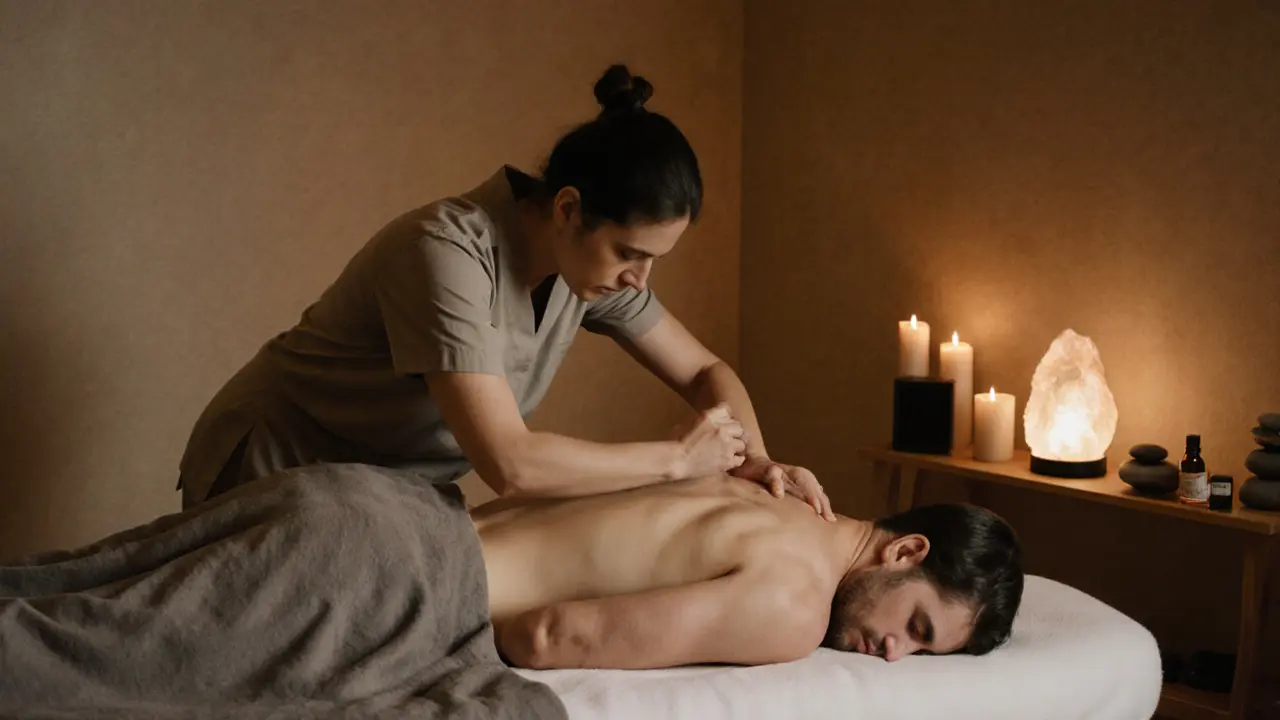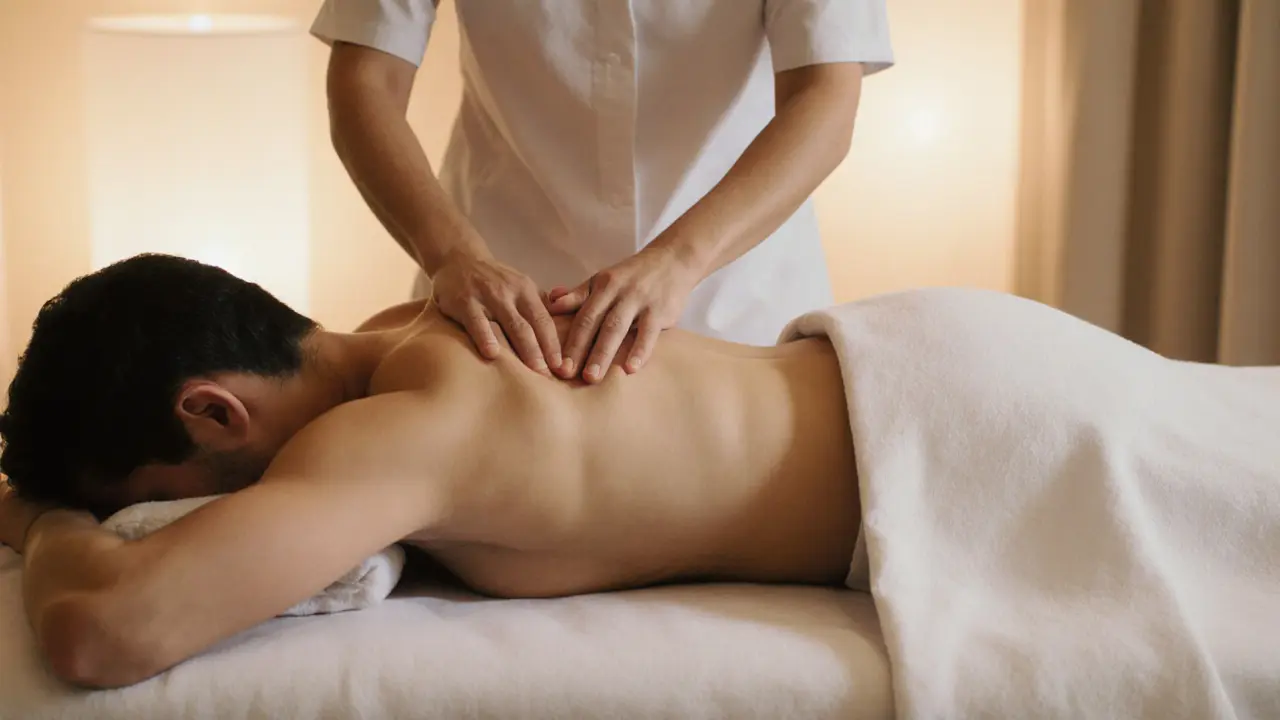When you hear the term deep tissue massage, you might picture a firm hand kneading away knots or wonder if the price tag is justified. Below, we break down what the therapy actually does, who benefits most, and how to decide if it’s a smart addition to your wellness routine.
Is it worth it to get a deep tissue massage? Your Comprehensive Guide
In this guide we’ll explore the origins, core techniques, real‑world benefits, safety tips, and where to find reputable practitioners. By the end you’ll have a clear answer to the question on everyone’s mind: is the investment worthwhile?
Understanding the Basics of Deep Tissue Massage
Origins and History
Deep tissue massage is a therapeutic technique that traces its roots to early 20th‑century sports medicine and manual therapy practices in Europe and the United States. Originally used by athletes to speed recovery, it gained popularity in the 1970s as a remedy for chronic musculoskeletal issues.
Core Principles or Components
The method focuses on the deeper layers of muscle and fascia, applying slow, concentrated pressure to release tension. Practitioners use their elbows, forearms, and even knuckles to target trigger points-tight spots that refer pain elsewhere. By increasing local blood flow, the massage helps flush out metabolic waste and encourages tissue healing.
How It Differs from Related Practices
While all bodywork aims to relax, deep tissue stands apart in intensity and goal orientation. Below is a quick comparison.
| Practice | Pressure Level | Primary Goal | Typical Session Length |
|---|---|---|---|
| Deep Tissue Massage | Firm to strong | Release chronic tension, improve mobility | 60‑90 min |
| Swedish Massage | Light to moderate | General relaxation, circulation | 50‑80 min |
| Trigger Point Therapy | Firm, focused on nodules | Deactivate specific pain points | 45‑75 min |
Where Swedish massage eases stress, deep tissue tackles stubborn knots, and trigger point therapy zeroes in on isolated pain spots.
Who Can Benefit from Deep Tissue Massage?
Anyone dealing with chronic muscle pain, limited range of motion, or post‑exercise soreness can see gains. It’s especially useful for athletes, desk‑bound professionals, and older adults battling age‑related stiffness. People with acute injuries, severe osteoporosis, or uncontrolled hypertension should consult a physician first.
Benefits of Deep Tissue Massage for Body, Mind, and Performance
Stress Reduction
By lowering cortisol levels and prompting the release of endorphins, the therapy provides a natural mood lift. Clients often report feeling calmer for hours after a session, which can translate into better sleep and reduced anxiety.
Enhanced Musculoskeletal Function
Targeted pressure helps break down adhesions in the fascia, improving joint flexibility and muscle length. This can boost athletic performance, reduce the risk of strains, and speed up rehabilitation after minor injuries.
Emotional Well‑Being
When chronic pain eases, emotional resilience often follows. The heightened sense of bodily control can improve confidence and lower feelings of helplessness associated with persistent discomfort.
Practical Applications
From preparing for a marathon to easing office‑related neck tension, the benefits translate into everyday productivity. Below is a snapshot of the top advantages.
| Benefit | Description | Impact on Daily Life |
|---|---|---|
| Pain Relief | Reduces chronic muscle soreness | Improved focus, fewer sick days |
| Increased Flexibility | Loosens tight fascia | Better posture, easier movement |
| Stress Management | Lowers cortisol, raises endorphins | Calmer mind, better sleep |
| Enhanced Recovery | Boosts circulation, waste removal | Faster healing after workouts |

What to Expect When Engaging with Deep Tissue Massage
Setting or Context
Sessions typically take place in a quiet, temperature‑controlled room with a massage table, soft lighting, and calming music. Some spas offer additional amenities like aromatherapy or heated stones to amplify relaxation.
Key Processes or Steps
- Consultation - you discuss pain history, goals, and any medical concerns.
- Positioning - you lie down comfortably; therapist adjusts pillows for support.
- Massage - firm strokes target deep muscle layers; pressure is adjusted based on feedback.
- Wrap‑up - therapist may stretch or give post‑session care tips.
Customization Options
Therapists can vary pressure, focus on specific body regions, or combine deep tissue with lighter techniques to lessen discomfort. Some clinics also integrate cupping or myofascial release for added benefit.
Communication and Preparation
Speak up about pressure levels; a good practitioner will ask, "Is this too intense?" before moving on. Arriving hydrated and avoiding heavy meals helps you stay relaxed throughout the session.
How to Practice or Apply Deep Tissue Massage
Setting Up for Success
Create a calm environment: dim lights, a comfortable massage table or firm floor mat, and soothing background sounds. Warm up the area with a heating pad if you have chronic stiffness.
Choosing the Right Tools/Resources
Look for a Licensed Therapist who holds certification from bodies like the American Massage Therapy Association (AMTA). Verify credentials, read client reviews, and ensure the practitioner maintains rigorous hygiene standards.
Step‑by‑Step Guide
- Book a 60‑minute slot with a certified therapist.
- Complete the intake form, noting any injuries or conditions.
- During the session, focus on breathing; exhale as pressure is applied.
- Afterward, drink water and stretch gently to prolong the benefits.
Tips for Beginners
Start with a lighter pressure session to gauge your tolerance. If you’re new to deep tissue, ask the therapist to blend techniques-alternating firm strokes with lighter effleurage-to avoid overwhelming soreness.

Safety and Ethical Considerations
Choosing Qualified Practitioners
Confirm that the therapist has a valid license and is a member of a reputable organization such as American Massage Therapy Association which sets education and ethical standards for massage professionals. Ask about continuing education in deep‑tissue techniques.
Safety Practices
| Practice | Purpose | Example |
|---|---|---|
| Hygiene | Prevent infections | Clean linens, hand sanitizer |
| Consent | Respect comfort levels | Check pressure every 5 min |
| Contraindication Screening | Avoid harm | Ask about recent surgeries |
| Post‑session care | Reduce soreness | Hydration, gentle stretching |
Setting Boundaries
Clearly state any areas you do not want touched. A professional will honor those limits and adjust techniques accordingly.
Contraindications or Risks
People with severe osteoporosis, acute inflammation, blood clotting disorders, or uncontrolled high blood pressure should avoid deep tissue or get medical clearance first.
Enhancing Your Experience with Deep Tissue Massage
Adding Complementary Practices
Combine the massage with mindfulness breathing, gentle yoga, or foam‑rolling on off‑days to extend muscle relaxation and improve proprioception.
Collaborative or Solo Engagement
If you have a partner trained in bodywork, you can practice light deep tissue at home, but always prioritize safety and avoid excessive force.
Using Tools or Props
Massage balls, foam rollers, and handheld percussion devices can mimic deep‑pressure stimuli between professional sessions.
Regular Engagement for Benefits
Scheduling a session every 4‑6 weeks maintains tissue health, prevents scar tissue build‑up, and keeps stress hormones in check.

Finding Resources or Experts for Deep Tissue Massage
Researching Qualified Experts
Search directories of the AMTA or local health‑authority registries. Look for therapists who list "deep tissue" as a specialty and have at least two years of experience.
Online Guides and Communities
Websites like Massage Therapy Forum host discussions, reviews, and tips from both clients and professionals can help you compare rates and read real‑world feedback.
Legal or Cultural Considerations
In the UAE, massage therapists must hold a valid work permit and follow Dubai Health Authority (DHA) regulations. Verify that the clinic displays its DHA license.
Resources for Continued Learning
Books such as "Therapeutic Massage in Athletics" and videos from accredited massage schools provide deeper insights into technique refinement.
FAQ: Common Questions About Deep Tissue Massage
What should I expect during a deep tissue massage?
You’ll begin with a brief health questionnaire, then lie on a padded table while the therapist applies firm, slow strokes to the deeper muscle layers. Expect occasional discomfort as tight spots are worked out, followed by a deep sense of relaxation once the tension releases.
Does deep tissue massage help with chronic back pain?
Yes. By increasing blood flow and breaking down adhesions in the fascia, the therapy can reduce muscle spasm and improve spinal mobility, which often eases chronic back discomfort. Results vary, so pairing sessions with core‑strength exercises yields the best outcomes.
How does deep tissue differ from Swedish massage?
Swedish massage uses lighter, flowing strokes to promote relaxation and circulation, while deep tissue targets the innermost muscle fibers with stronger pressure to address chronic tension. Think of Swedish as a gentle rain and deep tissue as a focused stream carving away rocks.
Is deep tissue safe for beginners?
It can be, as long as you work with a qualified therapist who tailors pressure to your comfort level. Start with a moderate session, communicate any pain, and allow 24‑48 hours for recovery before booking another.
How often should I get a deep tissue massage?
Most professionals recommend every 4‑6 weeks for maintenance, while athletes with high training loads may benefit from monthly sessions. Adjust frequency based on how quickly your muscles recover and your budget.
Conclusion: Why Deep Tissue Massage is Worth Exploring
A Path to Better Health
When used wisely, deep tissue massage can turn chronic aches into manageable sensations, boost flexibility, and lower stress hormones-making it a valuable tool in any wellness arsenal.
Try It Mindfully
Start with a qualified, licensed therapist, set clear goals, and give your body time to adapt. The payoff isn’t immediate for everyone, but many report noticeable improvement after a few sessions.
Share Your Journey
Have you tried deep tissue massage? Drop a comment below, and let us know how it impacted your life. Follow our blog for more wellness tips, and feel free to explore related services at reputable Dubai spas.
Disclaimer: Some links may be affiliate links, but all recommendations are based on research and quality.



Krishna Prasad Regmi
October 25, 2025 AT 15:46I’ve seen clients who were skeptical at first, but once they felt the tension melt away they became regulars.
Deep tissue isn’t just about pain – it can actually improve posture over time.
Start with a moderate pressure session and tell the therapist when it feels too intense.
Hydration after the massage helps flush out metabolic waste.
Stick to a consistent schedule, like every 4‑6 weeks, to keep the benefits rolling.
zulfa eliza
October 25, 2025 AT 16:46Honestly, the transformation you get from a solid deep‑tissue session is nothing short of dramatic.
Imagine your muscles as tangled rope – the therapist’s firm strokes are like a skilled sailor untangling it.
People often describe a post‑massage glow that lasts for hours, sometimes days.
It’s especially powerful for athletes who need quick recovery between training blocks.
Don’t be afraid of a little discomfort; that’s the scar tissue loosening.
Just make sure you’re communicating the pressure level throughout.
When you pair it with proper stretching, the results are amplified.
Give it a try and notice how your range of motion improves over the next few weeks.
Lauren de Bruyn
October 25, 2025 AT 17:46While the industry loves to market deep tissue as a miracle cure, there’s a quiet push to keep us hooked on recurring sessions.
Some large spa chains own the supply chain for massage oils and even the booking platforms, creating a feedback loop that benefits them more than us.
That’s why I always advise checking the therapist’s credentials independently, not just the spa’s glossy brochure.
Also, watch out for hidden fees that appear after the first visit – they can add up fast.
Remember, a single well‑executed session can be more effective than a series of half‑hearted ones.
Stay critical, stay informed, and you’ll get the real value out of your money.
akash gupta
October 25, 2025 AT 18:46Deep‑tissue massage leverages fascial‑release protocols and myofascial‑trigger‑point targeting to modulate proprioceptive feedback loops.
When you apply sustained pressure at ≥30 psi, you facilitate mechanotransduction pathways that enhance collagen remodeling.
For Indian clients accustomed to Ayurvedic practices, integrating warm oil‑infused drips can synergize the vasodilatory effect.
Always verify that the practitioner holds an AMTA certification and adheres to DHCA standards if you’re in the UAE.
Albert Sarvis
October 25, 2025 AT 19:46Dear colleague, your emphasis on certification aligns perfectly with best‑practice guidelines.
It is paramount that practitioners maintain a rigorous continuing‑education schedule to stay abreast of evolving biomechanical research.
Clients will benefit from a structured post‑session protocol that includes hydration, gentle stretching, and a brief mindfulness exercise.
Such a comprehensive approach ensures maximal therapeutic gain and fosters long‑term client trust.
I commend your commitment to professional excellence.
becky cavan
October 25, 2025 AT 20:46Sounds like a game‑changer!
Joel Barrionuevo
October 25, 2025 AT 21:46When I consider the philosophy behind deep‑tissue work, I’m reminded of the ancient notion that the body is a map of the mind.
Every knot can be seen as an unprocessed emotion, a stored story that the muscles cling to for protection.
By applying intentional pressure, we invite those stories to surface, allowing the conscious self to acknowledge and release them.
This process mirrors the therapeutic dialogue in psychotherapy, where the client gently confronts suppressed feelings.
Moreover, the physiological response-reduced cortisol and increased endorphins-creates a neurochemical environment conducive to emotional resilience.
From a practical standpoint, integrating regular deep‑tissue sessions with a habit of reflective journaling can amplify self‑awareness.
Think of the massage as a catalyst that clears the path for introspection to travel unimpeded.
Over time, you may notice that everyday stressors no longer trigger the same muscular tension patterns.
This shift is not merely physical; it reflects a deeper recalibration of the nervous system’s threat response.
In the context of modern life, where chronic stress is endemic, such recalibration can be life‑changing.
It also underscores the importance of approaching wellness holistically-mind, body, and spirit in concert.
Practitioners who understand this integrative model can tailor their techniques to each client’s unique narrative.
When you feel a deep release during a session, acknowledge it as a moment of personal insight.
That awareness can translate into better decision‑making, healthier relationships, and a clearer sense of purpose.
In sum, deep‑tissue massage offers more than muscular relief; it can be a doorway to greater self‑knowledge and emotional balance.